|
SMART WATERING AND DEEP WATERING TO SAVE PLANTS
During A Drought
“IT’S A LITTLE TOO LATE TO DO THE RIGHT THING NOW” is a song sung by Tanya Tucker which pretty well sums the planting situation we now find ourselves facing with this prolonged drought. People have a tendency to try to react to a situation when it occurs rather than take action before the situation occurs again to lessen the impact of the bad situation. Most regions of the country experience extremes in the environment, i.e., floods one year followed by no rains or drought. Weather conditions never seem to be “perfect” or balanced with moisture and temperature. “Averages” seem to be calculated using extremes in moisture and temperature. For instance, if a person stands with one foot in boiling water and the other foot in ice water, on the “average”, that person should be comfortable. What we must identify are plant materials which can perform in these extremes, i.e., Bush Morning Glory or Moon flower (Ipomoea fistulosa) grows as well in a swamp as it does in a desert. Most of the plants identified as Texas SuperStar Plants at: http://plantanswers.com/Articles/SuperStar_Plant_Listing.asp and landscape plants recommended for south central Texas at: http://plantanswers.com/publications/southcnt.html have the ability to endure environmental extremes if well- established (several years!) BEFORE the conditions become extreme.
“Drought-tolerant” plants should be referred to as “drought-survivable” plants. The plants do live through the experience but they are probably not as attractive or actively growing while the extremes are occurring. Drought-tolerant plants MUST BE planted well before the actual drought occurs so they can have an extensive and expansive rootsystem which can take advantage of every molecule of moisture which exists. The smaller a plants rootsystem, the less “adapted” to drought conditions. So it would be wise to wait until relief comes in the form of rains to moisten the subsoil before establishing adaptive drought-tolerant plants -- in preparation for the next drought period.
To make the situation even worse, woody plant material is also more difficult to establish during periods of prolonged drought. This is mainly due to depleted soil moisture which stimulates expansion and penetration of the young root system. When the soil profile is moist, roots can easily expand. When the soil profile is completely dry, roots are limited to the moisture added near the root ball which was established in the container in which it was grown. Because of this, the larger,woody transplants MUST BE watered directly at the base of the recently-established plants. Regardless of the wetness around the transplant’s rootball, if the rootball itself is not wetted , the plant will die. Once dry, a plant’s rootball is almost impossible to wet while planted in the ground. To avoid this, soak the rootball of plants BEFORE planting them. Then supplemental water must be added slowly to allow complete soaking of the rootball and the recently-established plants must be watered at least weekly for the first six months and/or until at least one-inch of rainfall per week occurs. With no moisture in the soil and a concentrated root system, the transplant has to be handled as if were still growing in the plastic container in which it was purchased. In nurseries, the majority of plants in containers are watered daily and some more often during adverse weather conditions of extreme heat.
In soil, as in containers, if the rootball dries, even once, the plant will be severely damaged, if not killed, i.e., if it dries – it dies.
Neil Sperry likes the water bubbler to allow rapid watering while avoid run-off:
Water bubbler costs only a few dollars, allows rapid watering. Once you have one you’ll never be without one. The Water bubbler can run at full volume, yet the water flow is little more than a bubbling brook.
New plants must be watered by hand for their first couple of years in their new planting sites. Sprinkler irrigation won’t cut it. Drip irrigation won’t do it. Those silly bags of water strapped around plants’ trunks are a joke.
You must soak them deeply, and you must do so frequently.
The easiest way to accomplish both tasks is to form a water-retaining berm around each plant by using the soil you have left over after you plant it. Think of it as a donut-shaped levee around every plant.
And then buy yourself a water bubbler and a water wand and water the plants by hand.
But does it work? Yes, when nothing else does.
Dwarf yaupon holly was just planted from a 5-gallon pot. It will get 5 gallons of water every other day for the first couple of summers.
Give each plant as much water as the container size from which it was planted. If it came out of a 5-gallon pot, give it 5 gallons of water every 2-3 days. If it came out of a 20-gallon pot, give it 20 gallons of water every 2-3 days.
Don’t be surprised if you have to water the plants twice to get that much water to soak into their soil. That’s OK. Trust me – it would be almost impossible to over-water plants at these temperatures.
Do that until temperatures start to fall in mid-September. If you get a 2-inch rain at your house, you can skip one day.
Folks, I realize most Texas cities are asking that we cut back on water consumption. However, do it somewhere else. Your shade trees aren’t going to die if you don’t water them for a couple of weeks. Established shrubs have a greater margin of error. But new plants have almost no leeway. Miss a day and your time, effort and investment may have been wasted.
A once lovely new dwarf Burford holly was lost because the person charged with watering it didn’t realize the signs of a drought-stressed plant.
PERSONALLY I PREFER A NEW SPRINKLER NAMED
“THE TREE HUGGER”
This is NOT Drip Irrigation since Neil Sperry rightly notes “Drip irrigation won’t do it.” Since Drip Irrigation is only for “supplemental” watering and NOT for wetting (pre-irrigation before planting) a soil’s complete profile. Rather than calling this watering during a drought Drip Irrigation, I propose to name it:
EXTREME LOW VOLUME FLOW CAUSING A SLOW, DEEP SOAK
This can involve the TreeHugger (7 inch pictured below costs $21) or a larger Hugger (11 inch for $35) from Milberger Landscape Nursery or on the Internet. Or, if you are the “conservative” type (I will refrain from using the term: Cheap!), you can use your old sprinkler and adjust the flow from the water hydrant; BE SURE to use a clock timer (sold previously as Gilmour timers now sold as Orbit on the Internet or in Nurseries for $16 rather than a water-flow timer) in case you forget to turn it off. Images are:
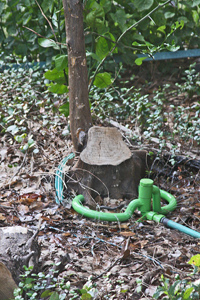
|
| TreeHugger is used to keep the citrus trunk (killed during the 2021 hard freeze) and new growth moist during a severe drought. |
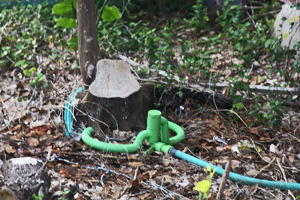
|
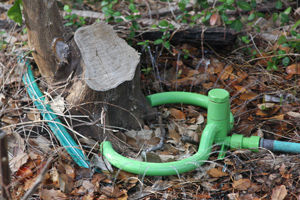
|
|
The flow stream is controlled at the faucet and should never be over 4-6 inches to insure maximum penetration with little if any runoff.
|
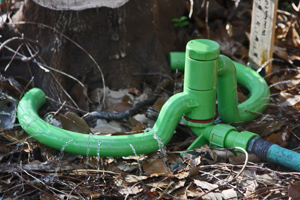
|
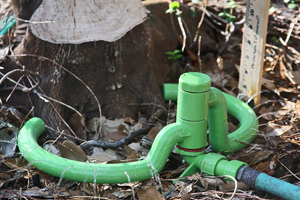
|
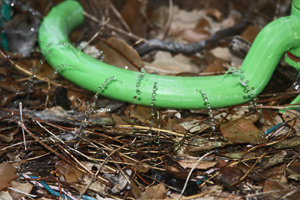
|
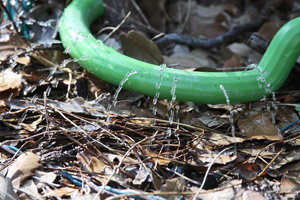
|
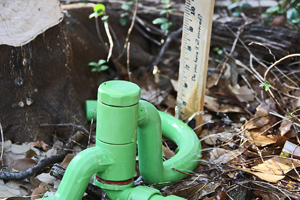
|
|
| The flow stream is controlled at the faucet and should never be over 4-6 inches to insure maximum penetration. |
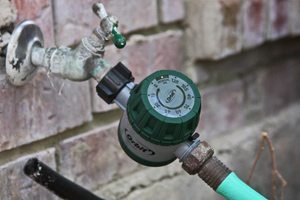
|
|
BE SURE to use a clock timer (sold previously as Gilmour timers now sold as Orbit on the Internet
or in Nurseries rather than a water-flow timer) in case you forget to turn it off – A “must” for older citizens SUCH A ME!!!
|
You can use your old sprinkler and adjust the flow from the water hydrant.
|
|
|
|



